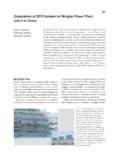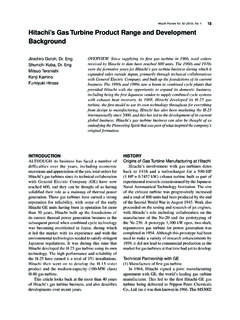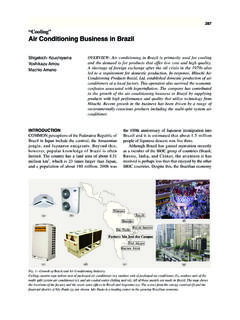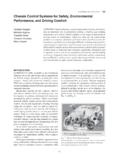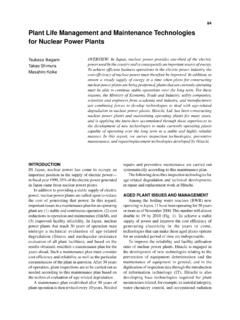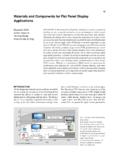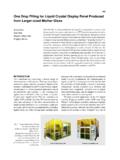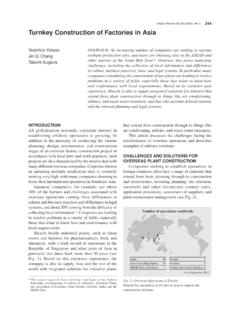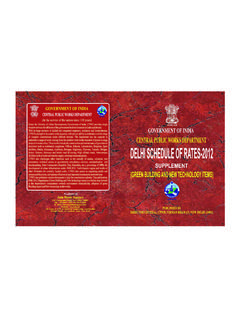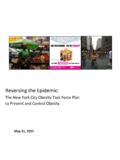Transcription of New Solution for Urban Traffic: Small-type …
1 Hitachi Review Vol. 50 (2001), No. 4 139. New Solution for Urban traffic : Small-type monorail system Takeo Kuwabara OVERVIEW: In Japan, the first Urban straddle type monorail system , Tokyo Motomi Hiraishi monorail , was put into operation in 1964. Since then, three more monorail systems have been constructed with the active participation of Hitachi in Kenjiro Goda Kitakyushu, Osaka, and Tama. A monorail system is now being constructed Seiichi Okamoto in Okinawa; it is scheduled to start operation in 2003. The straddle type Akira Ito monorail can be constructed using the space above public roads without Yoichi Sugita disturbing everyday traffic . monorail trains with rubber tires are environmentally friendly and produce little noise and vibration. The straddle type monorail has become an important part of the Urban public transportation system , chiefly because of its many advantages over other transportation means including the subway. These advantages include (1). improved environment, (2) a shorter construction period, and (3) lower costs.
2 Thus, the monorail system in Japan is an effective Solution to environmental problems and traffic congestion in Urban cities, which also stimulates local economy. The demand for Urban monorail systems has recently begun to come from smaller local cities where the daily ridership is much lower than that in Tokyo, Osaka, Kitakyushu, and other major cities in Japan. To enhance the financial viability of monorail construction in smaller cities and to construct smaller monorails, the Japan monorail Association (JMA) set up a research committee to investigate the development of a small monorail . This committee, mainly headed by Hitachi, carried out comprehensive research of the market demand for monorail systems and initiated the development of a compact monorail . Hitachi developed a number of new design elements including an articulated bogie to enable trains to negotiate sharp curves. We also worked to design a compact and light monorail that makes use of next-generation signal systems.
3 These basic elements can also be used for other people-mover systems in amusement parks, airports, and business complexes. Conventional train Fig. 1 Concept of New, small - type monorail system in 2-story Bus terminal Harmony with the Urban depot 40-m curve Amenity. radius Intermediate station Based on monorail know-how (including traction power facilities) obtained from past construction 60 steep gradient projects, we developed a straddle type small monorail system with compact, standard, and low-cost Subway configuration that meets the station Subway transportation needs of medium- and small -size cities. This small - type monorail system has a number of features that make it Artistic impression of Small-type monorail cars flexible toward the requirements in operation of various transportation agencies. New Solution for Urban traffic : Small-type monorail system 140. INTRODUCTION (4) Right-of-way for Small-type monorail systems HITACHI has already completed the development of The guideway structure and station building can a Small-type monorail system that meets the needs for be constructed above narrow streets.
4 Economical construction and smaller monorails in Routes can be flexibly designed along existing regional cities. This paper describes the main features roads and streets with a 40-m curve radius and a 6%. of our Small-type monorail system . gradient. (5) Smooth and seamless connection to other means TECHNICAL FEATURES of transportation A reduced axle load is one of the main features of We improved platform design to make transfers the guideway structure of our monorail train. In our easier. train, the load on axles is 8 tons per axle instead of 10 The monorail can be built underground. to 11 tons per axle as in large conventional monorail trains. The main features of the Small-type monorail COST CONSIDERATIONS. system are these: (1) Optimization of technical specifications (1) small and light vehicles. Our system features small and light vehicles, We have improved our vehicle design technologies reduced train length, reduced number of passenger to produce an economical vehicle. doors, which in turn reduces the guideway structure, The train models have been standardized (two station platform length, and the number of platform models are currently available).
5 Screen doors. The exterior of the trains can be decorated with Due to the use of traction power substations colored films. operating at 2,000 kW, we can use commercial Seats in the trains can be arranged based on incoming power lines at substations, which reduces customers' specifications. the amount of space for substations. (2) Greater passenger carrying capacity (see Fig. 2). The signaling system is equipped with an The passenger carrying capacity of a 4-car vehicle electronic interlocking device, which eliminates is 200 passengers (based on standard unnecessary cables and wiring. New regenerative occupancy) and passenger loading capacity in terms power absorbing facilities have been installed to of pphpd (passenger per hour per direction) is 3,000 replace the regenerative power facilities on the wayside pphpd (for an operating headway of 4 min). of the tracks. The daily passenger volume is 25,000 to 30,000 To reduce the amount of required space for depots passengers. and train storage yards, train lines can be constructed (3) The cost of our system is 50% that of large-type on the 2nd floor and the operation control and monorail system .
6 Maintenance center will be located on the ground floor. The total construction cost has been reduced to (2) Compact station buildings half that of large-type monorail system . Side-platform arrangement for intermediate Operating headway (min) Note: Passenger carrying capacity per car 10 6 (standee occupancy rate: m2/passenger). 5,000. (number of passenger onboard per train). Small-type monorail 79 passengers/car 2,600. Passenger carrying capacity per train 2,000 Subway 10 cars/train Large-type monorail 173 passengers/car 4 cars/train 1,384 6 cars/train Subway 260 passengers/car 1,000. 8 4 cars/train Large-type monorail Bus 70 passengers/car 632. 500 AGT 4cars/train 8 cars/train Small-type monorail cars/train 4 cars/train AGT 80 passengers/car 316. 200 Example of Small-type monorail LRT 100 passengers/car 2 cars/train 4 cars/train 1 car/train LRT AGT: automated guideway transit 100 Operating headway: 6 min LRT: light rail transit 70 1 car Bus Passenger loading capacity: 3,000. 50 pphpd 20.
7 400 1,000 2,000 3,000 5,000 10,000 20,000 50,000 100,000. Fig. 2 Passenger Carrying Capacity of Different Passenger loading capacity (in term of pphpd). Transportation Systems. The passenger carrying capacity of Small-type monorail is about the same as that of AGT. Hitachi Review Vol. 50 (2001), No. 4 141. stations eliminates the need for concourse floors and been simplified. makes station buildings 2-story structures rather than 3-story structures. system CONFIGURATION. There are no escalators at intermediate stations, Comparing Our system with Conventional only elevators and stairs. Large-type Monorails (3) Standardized design Fig. 3 compares our Small-type monorail with a Train components have been standardized, except conventional large-type monorail . for passenger seating arrangement and vehicle exterior for which there are two standard models. monorail Trains Making the intermediate station a side-platform The goals in designing the Small-type monorail type, instead of an island-platform type, keeps the were (1) to reduce the number of cars in a train and tracks straight and simplifies station structure.
8 (2) to make train cars lighter and more compact. This (4) Other features reduction in size has a remarkable cost-saving effect Using commercial incoming lines to power station since the loading impact on the guideway structure equipment eliminates the need for low-voltage becomes smaller. distribution networks and additional cables. (1) Because there is not much space under the frame The prestressed concrete (PC) tracks and steel of a monorail car to install equipment, we used an track girders were made rectangular to reduce the cost articulated bogie for our train. of constructing the guideway structure. (2) To enable the train to negotiate sharp curves to The signal, operation control, and communication follow narrow roads in local cities, the minimum curve systems were integrated into one system to reduce radius was set at 40 m. costs. After we completed the design of the new bogie, The trolley wire design of power feeder lines has we carried out a series of tests on a prototype bogie by Car comparison (4-car train).
9 Large type small type Large type small type Weight 11 t 8 t (average). Train configuration 4 cars 4 cars Nominal capacity 415 passengers/train 194 passengers/train Seating: 177 Seating: 88. Standing: 238 Standing: 106. Planned capacity 692 passengers/train 315 passengers/train Full capacity 966 passengers/train 406 passengers/train Large type small type Signal loop Power-supply Inter-station cable Control cable cable Unit: m Fig. 3 Large-type and Small-type Monorails. Small-type monorail system reduces the cross section of guideway structure and stations, and simplifies cable laying between stations. New Solution for Urban traffic : Small-type monorail system 142. Tc2 M2 M1 Tc1 Running-tire slip angle ( ). Air-spring longitudinal rigidity Circular curve Small-type monorail Small-type monorail Urban -transit type Running tire Low-rigidity air Conventional air monorail Transition spring (radius: 40 m) spring (radius: 40 m) Conventional air Guide tire Straight curve track spring Curve profile (radius: 50 m).
10 Articulated bogie Stabilizing tire (a) Decrease in running-tire slip angle Guide-tire force (N). 15,700. Fig. 4 Dynamic Simulation Model. 15,000 12,900. A design verification model was developed to examine the 10,000 8,130. articulated-bogie system of the Small-type monorail , and the riding comfort of passengers was evaluated when the train was 5,000. passing a small curve with a 40-m radius. 0. Small-type monorail Small-type monorail Urban transit-type Low-rigidity air Conventional air monorail spring (radius: 40 m) spring (radius: 40 m) Conventional air simulating actual operating conditions. spring (1) To reduce the increased load on the axles due to a (radius: 50 m). (b) Decrease in guide-tire force smaller number of axles supporting the overall weight Fig. 5 Results of Dynamic Simulation. of the train, the average axle load is controlled at 8. Design elements affecting the lifetime of various tires in relation tons per axle. to the train's ability to pass small curves were analyzed, and an (2) To increase passenger comfort, the wheel springs air-spring constant that can ensure the riding comfort and damper systems of the bogies have been carefully equivalent to that of conventional systems was determined.
